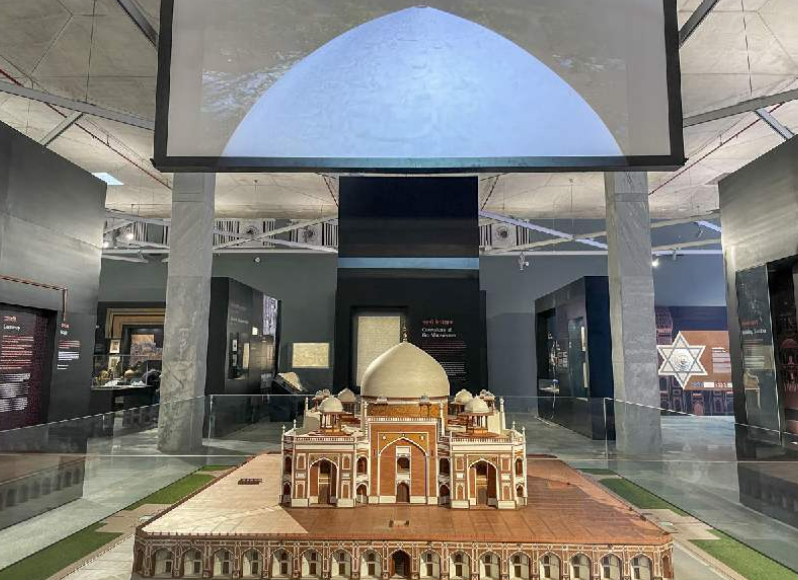India’s First Sunken Museum to Open at Humayun Tomb (GS Paper 1, Arts & Culture)

Introduction
- India is poised to unveil its first sunken museum, a groundbreaking addition to the Humayun Tomb complex in Delhi.
- The museum's grand opening is set for July 29, 2024, with public access beginning on July 30.
- This significant event coincides with the 46th UNESCO World Heritage Committee session, where Union Culture and Tourism Minister Gajendra Singh Shekhawat and Prince Rahim Aga Khan will be present.
- The museum's inauguration marks a milestone in India's cultural and architectural heritage.
Historical Significance of Humayun’s Tomb
- Humayun’s Tomb stands as a monumental testament to Mughal architecture, constructed in the mid-16th century under the patronage of Empress Bega Begum, the widow of Emperor Humayun.
- Recognized as a UNESCO World Heritage Site, the tomb is celebrated for its grandiose design and is a pioneering example of Mughal garden tombs.
- Its architectural influence extends to the Taj Mahal, showcasing the Mughal commitment to symmetry, grandeur, and intricate design.
- The tomb is distinguished by its imposing central dome, flanked by symmetrical gardens and a vast charbagh (four-fold) layout.
- These features reflect Persian architectural influences and set a precedent for subsequent Mughal architecture.
- The structure's use of red sandstone and intricate patterns highlights the artistic and cultural achievements of the Mughal era.
Innovative Museum Design
- The new sunken museum draws inspiration from traditional Indian stepwells, or ‘baolis,’ integrating historical architectural elements with contemporary exhibition techniques.
- This design approach creates a visually striking and immersive environment, enhancing the visitor experience by connecting them with historical architectural styles in a novel way.
- The museum's sunken design ensures that it blends harmoniously with the surrounding landscape while providing a modern and engaging space for showcasing historical artifacts.
- The strategic use of space and light in the museum's architecture highlights both its historical roots and its commitment to innovative design.
Museum Highlights and Features
- Artifacts and Exhibits: The museum will display an impressive collection of historical artifacts, including items that were restored from Humayun’s Tomb after it sustained damage from storms in 2014. Notable exhibits will include ancient decrees, an astrolabe, a celestial sphere, and a 16th or 17th-century warrior’s helmet. These artifacts offer a glimpse into the rich history and culture of the Mughal period.
- Technological Integration: The museum employs cutting-edge technology to enhance the visitor experience. Features include 3-D projections that recreate historical scenes, providing a dynamic view of the past. Detailed scale models of the nearby Nizamuddin Dargah complex, a 14th-century site, will also be on display. These models illustrate the historical development of the site and offer insights into its architectural evolution over time.
- Educational and Interactive Elements: The museum aims to provide an interactive and educational experience through digital displays and multimedia presentations. These elements are designed to engage visitors of all ages and offer a deeper understanding of the historical and architectural significance of the artifacts and the Humayun Tomb complex.
Strategic Location and Impact
- Construction of the museum began in April 2015, with the initial completion target set for 2017.
- Its strategic location at the entrance of the Humayun Tomb complex serves as a gateway to the World Heritage site, connecting various cultural landmarks within the area.
- The museum is expected to attract a diverse audience, including tourists, historians, and architecture enthusiasts, and will play a key role in enhancing the overall visitor experience at the complex.
Conclusion
- The opening of India’s first sunken museum at the Humayun Tomb complex represents a landmark achievement in the preservation and presentation of cultural heritage.
- By combining traditional architectural inspiration with modern technological advancements, the museum not only enriches the narrative of Mughal history but also sets a new standard for museum design and visitor engagement.
- This innovative addition to the Humayun Tomb complex underscores India's commitment to preserving its rich cultural legacy while embracing contemporary approaches to heritage presentation.


